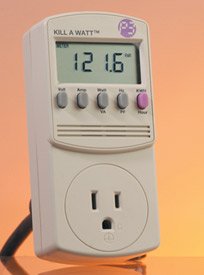How to Measure Home Power Usage!
Electricity costs money.
When you're looking at your electricity bill, you're bombarded with a lot terms and abbreviations that seem pretty meaningless.
The Kilowatt Hour (kWh, sometimes styled as "kW h" or "kW-h", but NEVER "kW/h") measures energy.
What you need to know:
if a device is rated to generate 1 kW of power, and if it operates for one hour at that level, it sustains 1 kWh of energy.
1kWh = 1000Wh
100 watts over 2hr = 100x2 = 200watts = 200/1000 = .2kWh
100 watts over 10hrs= 100*10= 1000Watts = 1000/1000= 1kWh
There are three ways to measure how much electricity something uses:
simple watt-hour meter.
you can cut down on costs and find out what appliances are actually worth keeping plugged in. Simply connect these appliances to the Kill A Watt, and it will assess how efficient they really are.

install a whole-house meter.
Once installed TED, you can begin seen instant electricity usage in dollar amounts.

Look at the meter on the side of your house and time it.
Clocking your electric meter is cumbersome, but it's free. My calculator will make the job a little easier.
STEP 1: Find the kH factor of your meter. It's almost always printed on the meter, as in "1.0kH" or "kh7.2". Digital meters are usually 1.0 kH and old analog meters are usually 7.2 kH. (Some digital meters are really 1.0 kH but are mislabeled 7.2; if your calculator results with your digital meter seem 7.2x too high, type in 1.0 instead.)
STEP 2: Decide what you're going to count.
The quick & dirty way is to count the number of seconds it takes for one beat of a digital meter (or one revolution of an old analog disc). This method is easy but it's not as accurate for low-wattage devices. If it takes at least 15 seconds for a beat, this method is fine, but if it's faster than that, use the next method.
The more accurate method is to count how many seconds it takes for multiple beats (e.g., 5 beats, 10 beats, your choice). The more beats you use, the more accurate your results, but the longer it will take you to count out all those beats.
STEP 3: Choose the "Read-Once" or "Read Twice" method:
Read-Once Method (You have to unplug everything, but you have to read the meter only once.)
Turn ON the device you want to measure, and turn OFF and unplug everything everything else, including the air conditioner, heating system, and refrigerator. (If they kick in or shut off while you're making your measurements, that will change the results.)
Go outside and time your meter, as per STEP 2 above.
Plug the number into my calculator.
Read-Twice Method (You can leave most things plugged in and/or turned on, but you have to read the meter twice).
Turn ON the device you want to measure, and turn OFF things that could suddenly turn on by themselves such as your refrigerator, air conditioner, or heating system.
Go outside and time your meter, as per STEP 2 above.
Plug the number into my calculator below. Click "Two-Reading Method" so you'll have space to enter your next result.
Go inside and turn off the device you're measuring.
Go outside and time your meter, as per STEP 2 above.
Plug the number into the calculator.
https://energy.gov/energysaver/estimating-appliance-and-home-electronic-energy-use

The faster you go, the shorter you are.
- Albert Einstein